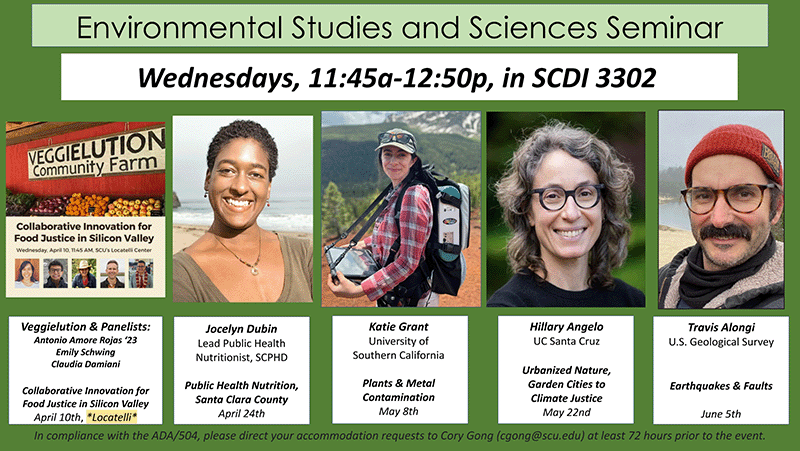
ESS Seminar Series
The Department of Environmental Studies and Sciences brought together five speakers in this past spring quarter. Here’s a snapshot of the wonderful talks!
Collaborative Innovation for Food Justice in Silicon Valley
Veggielution & Panelists: Antonio Amore Rojas ‘23, Emily Schwing, & Claudia Damiani
This panel brought together Veggielution, including Emily Schwing, Antonio Amore Rojas '23 (Management, Environmental Studies), Claudia Damiani, and Fernando Fernandez Leiva, with ESS's Christopher Bacon as the presenters reflected on how the SCU-Veggielution partnership can create a more diverse, equitable, and resilient regional food economy in the South Bay area and to bring awareness of the Santa Clara County Food System Work Plan. A recording and more info are available on the Environmental Justice and the Common Good website.
Putting Research Into Practice: Public Health Nutrition, Santa Clara County
Jocelyn Dubin
On local, regional, national, and international levels, we know that a person’s nutritional status accounts for 40-90% of their overall health and well-being. Jocelyn Dubin, the Lead Public Health Nutritionist in the County of Santa Clara Public Health Department’s Healthy Communities Branch, presented on Santa Clara County’s goals of public health nutrition. Her work helps support making the health choice the easy and most prevalent choice for all county residents.
Can PlantsTell Us About Metal Contamination Through Their Hyperspectral Reflectance?
Katie Grant
Human activities have caused heavy metals to build up in soils worldwide, posing health risks to vulnerable human, animal, and plant populations. Katie Grant, PhD Candidate of Earth Sciences at University of Southern California and Visiting Student Researcher at NASA JPL, presented on how a deeper understanding of heavy metal contaminant transportation is possible through a combination of hyperspectral remotely sensed data and extensive ground-based measurements of plants/soils. Through her work, further comprehension of large-scale remediation efforts and water quality protection were possible.
How Green Became Good: Urbanized Nature from Garden Cities to Climate Justice
Hillary Angelo
From China to California, self-described “greening” efforts claiming to address inequality and the climate crisis proliferate. But why are such projects—undertaken in the name of sustainability, resilience, and quality of life—being carried out in such a wide range of places with very different histories, ecologies, and cultural repertoires for urban life? Based on a historical study of Germany’s Ruhr Valley, Hillary Angelo, PhD, Associate Professor of Sociology at the University of California, Santa Cruz, offers a sociological explanation of urban greening as a global, contemporary phenomenon. Check out her book, How Green Became Good (2021).
Offshore Earthquakes and Faults in California
Travis Alongi
Many of the world’s most damaging faults are offshore, presenting unique challenges and opportunities for studying earthquakes and faults. Travis Alongi, PhD, Mendenhall Research Geophysicist with the USGS Earthquake Hazards Program presented how earthquake-generated (passive) and human-made (active) marine seismic methods improve our knowledge of on-fault slip behavior and off-fault damage.
The first part of my talk explores the shallow offshore portion of the southernmost Cascadia subduction zone using earthquake patterns. We develop a high-quality seismic catalog using a dense amphibious array of seismometers and advanced location techniques to provide constraints on the faulting. The second part of my talk focuses on the in-situ spatial distribution of secondary faults surrounding the main fault identified using marine-controlled source seismic reflection imaging. To better understand the damage zone, we develop a workflow to automate the detection of faults in seismic images. Using this method, we show a peak in fault damage occurs at the location of the main fault strand. We find that several factors influence the fault damage patterns such as rock type, overall displacement across the fault, and the shape of the fault.